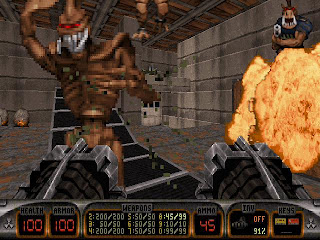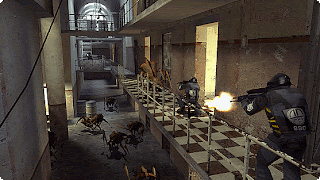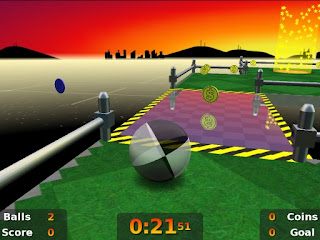Graphics: Opium for the Eyes
Graphics. Our society places heavy emphasis on what we see. Not surprisingly, we also judge games by their graphics.
Judging games by their graphics, has become a staple of gaming reviews. Hard-core gamers, game developers and critics can tell the general age of a game by its graphics. Even the untrained eye can differentiate between an old style game from the 90’s with more recent games.
 3D Realm’s Duke Nukem (January 1996)
3D Realm’s Duke Nukem (January 1996)
 Valve’s Half-Life 2 (November 2004)
Valve’s Half-Life 2 (November 2004)
But are graphics everything? Not if you ask older gamers, those who like me saw everything from Nintendo’s original 8-bit Zelda to the newest HDR lightened, high-polygon, physics engine Half-Life 2 Episode 1 game.
Most people that I know, actual play games because they find games fun. Many a pretty looking game turned out boring. And many “old-school” low budget graphics games enticed me to play for hours. Some gamers swear that the most important element in a game is gameplay or simply put fun. Some firms such as UK based indie game developer Introversion lives by focusing on gameplay.
Simplicity in Graphics
Unlike many in the younger crowd of gamers, I believe that one does not need the newest, greatest and latest in graphics to make enticing graphics. Often times, a simple image can fit nicely in place of a complex one. Introversion proved that a market exists for both the latest in eye-candy and simpler graphics with their second game, Darwinia.
The game follows the story of flat, sprite-like AI creatures called Darwinians, and their struggle to survive in a hostile, virus laden world. The graphics of the game inspired by early vector games, also follows the idea of simplicity. While Darwinia graphics set to full, still makes my nVidia GeForce 6800 work for its living, the overall style is simplistic. Maybe even overtly simplistic. But given the story, and type of game, the graphics fit perfectly. Can open source gaming follow the simple, attractive graphics route?
Neverball: Simple Attractive Graphics in Open Source Games
Complex, eye-candy Half-Life 2 style graphics requires tons of time and work to make. Developing a graphics/game engine can handle such graphics is also costly. Buying an engine, like id’s Doom or Valve’s Source can cost too much for indie game companies. Indie game developers do not have the money to afford such eye-candy in their games. Open source game developers have even less resources at their disposal. And so competing on the high-end graphics does not make sense for open source game developers.
However, open source games can still look good, even in 3d. Take the Neverball project for example. The graphics don’t not scream “TIME TO UPGRADE!”, but fit well into the context of the game. True, the icculus group is very experience, has worked on a number of 3d games, and helped companies like Epic bring their games into Linux. Still Neverball‘s graphics, with their colour, bright, simple textures and shinniness look impressive for this type of game. I do not see how any more realistic lighting or textures or models could make the game’s look and feel significantly better.
Screenshots never do justice to a game. Go to the Neverball website and try it out. I think the developers of Neverball showed that a game can be fun, look good and still be open source.
Edit: Sorry about the links, uploaded the screenshot images instead.

